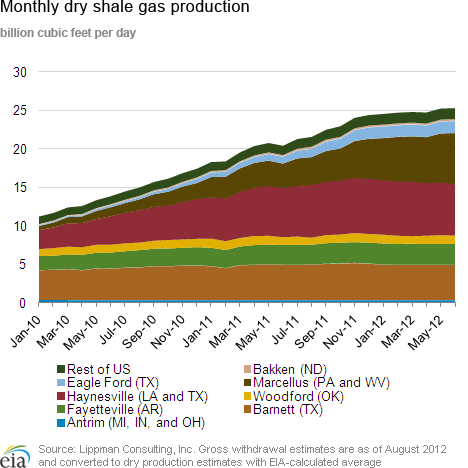In the News:
Underground working natural gas storage capacity increased from April 2011 to April 2012, according to a recent report released by the U.S. Energy Information Administration (EIA).
The report measures capacity in two different ways: demonstrated peak working gas capacity, which is the sum of the highest observed working natural gas storage inventory level in each facility over the prior 5-year period; and working gas design capacity, which is a measure based on the physical characteristics of the reservoir, installed equipment, and operating procedures particular to the site that is often certified by Federal or State regulators. Demonstrated capacity is a more conservative estimate than design capacity, since it represents observed maximum levels of inventory rather than theoretical, nameplate capacity. Demonstrated capacity increased from 4,103 billion cubic feet (Bcf) last year to 4,239 Bcf this year and design capacity increased from 4,388 Bcf to 4,498 Bcf. The increases were largely in traditional storage in the West Region and salt cavern facilities in the Producing Region.
Overview:
(For the Week Ending Wednesday, September 19, 2012)
- Natural gas prices declined at most trading locations this week, erasing gains from last week. The spot price at the Henry Hub fell from $2.96 per million British thermal units (MMBtu) last Wednesday, September 12, to $2.70 per MMBtu yesterday, September 19.
- Natural gas futures prices declined along with spot prices. The New York Mercantile Exchange (NYMEX) near-month contract (October 2012) fell from $3.063 per MMBtu last Wednesday to $2.762 per MMBtu yesterday.
- Working natural gas in storage rose last week to 3,496 Bcf as of Friday, September 14, according to EIA's Weekly Natural Gas Storage Report (WNGSR). An implied storage build of 67 Bcf for the week positioned storage volumes 320 Bcf above year-ago levels.
- The natural gas rotary rig count, as reported by Baker Hughes Incorporated on September 14, fell by 4 to 448 active units.
Prices:
Natural gas prices declined in most market locations, likely reflecting lower demand for air conditioning. At the Henry Hub, natural gas prices fell 26 cents from $2.96 per MMBtu last week to $2.70 per MMBtu yesterday. A steady decline began on Friday, following a small increase near the beginning of the report week. The Henry Hub price increased to $3.01 per MMBtu in trading on Thursday, rising above $3 for the first time since early August. Most prices around the country followed a similar pattern to the Henry Hub with exceptions in the Northeast, where prices at New England trading points increased as a result of major pipeline maintenance on Algonquin Gas Transmission's system. The price at the Algonquin Citygate, which serves Boston-area consumers, rose to $4.52 per MMBtu on Monday, an increase of $1.47 per MMBtu from the previous trading day. The price increase was short-lived; by Wednesday the Algonquin price had fallen back to $3.72, a net increase of 1 cent per MMBtu for the whole week.
U.S. consumption fell 3.7 percent this week, according to data from Bentek Energy. Consumption of natural gas for power generation declined 13.1 percent, reflecting reduced air-conditioning demand as summer temperatures continued to subside. Natural gas consumed for electric power generation declined by 9.8 percent in the Southeast, the largest regional consumer of natural gas for power generation. Residential and commercial consumption rose 12.9 percent, partially offsetting the declines in power burn. The rise in residential and commercial consumption reflects increases in heating demand in some areas of the country. Industrial demand also rose slightly over the week, by 1.5 percent.
Total supply rose by 1.3 percent over the report week. Dry production rose by 1.6 percent, and was partially offset by declines in Canadian imports to the West and Northeast. Liquefied natural gas (LNG) sendout rose 13.3 percent, averaging 224 million cubic feet per day. Despite the week-over-week increase, LNG sendout is at a historically low level, and close to 44 percent below sendout for the same week last year.
At the NYMEX, the price of the near-month contract (October 2012) fell about 30 cents, from $3.063 per MMBtu last Wednesday to $2.762 per MMBtu yesterday. The 12-month strip (the average of the 12 contracts between October 2012 and September 2013) declined to $3.353 per MMBtu from $3.510 per MMBtu last week.
Storage
Working natural gas in storage increased to 3,496 Bcf as of Friday, September 14, according to EIA's WNGSR. This represents an implied net injection of 67 Bcf from the previous week. This week's injection was 6 Bcf below the 5-year (2007-2011) average injection of 73 Bcf, and 22 Bcf below last year's injection of 89 Bcf. Inventories are currently 320 Bcf (10.1 percent) greater than last year at this time and 278 Bcf (8.6 percent) greater than the 5-year average.
All three storage regions posted increases this week. Inventories in the East, West, and Producing Regions increased by 44 Bcf (the 5-year average net injection is 48 Bcf), 3 Bcf (the 5-year average net injection of 8 Bcf), and 20 Bcf (the 5-year average net injection of 17 Bcf), respectively. In the Producing Region, working natural gas inventories increased 10 Bcf (4.8 percent) in salt cavern facilities and increased 10 Bcf (1.1 percent) in nonsalt cavern facilities.
Temperatures during the storage report week were 0.3 degrees warmer than the 30-year normal temperature and 0.9 degrees cooler than the same period last year. Temperatures in the lower 48 States averaged 69.4 degrees, compared to 70.3 last year and the 30-year normal of 69.1 degrees. While overall temperatures were a little warmer than normal, temperatures varied somewhat across Census divisions. The Pacific Census division in the West was particularly warm, averaging 3.6 degrees warmer than the 30-year normal. Temperatures in both the East North Central and East South Central Census divisions were cooler than the 30-year normal by a degree.
See also:
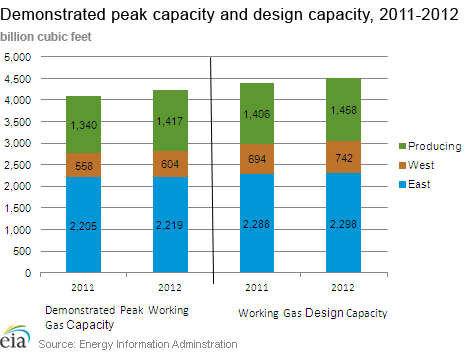
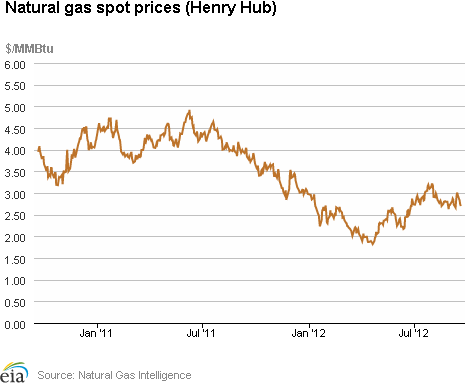
| Spot Prices ($/MMBtu) | Thu, 13-Sep |
Fri, 14-Sep |
Mon, 17-Sep |
Tue, 18-Sep |
Wed, 19-Sep |
|---|---|---|---|---|---|
| Henry Hub | 3.01 |
2.94 |
2.83 |
2.74 |
2.70 |
| New York | 3.09 |
2.97 |
2.89 |
2.92 |
2.91 |
| Chicago | 3.12 |
3.01 |
2.93 |
2.90 |
2.92 |
| Cal. Comp. Avg,* | 3.22 |
3.13 |
3.05 |
3.03 |
3.04 |
| Futures ($/MMBtu) | |||||
| October Contract | 3.037 |
2.943 |
2.865 |
2.773 |
2.762 |
| November Contract | 3.164 |
3.083 |
3.015 |
2.961 |
2.945 |
| *Avg. of NGI's reported prices for: Malin, PG&E citygate, and Southern California Border Avg. | |||||
| Source: NGI's Daily Gas Price Index | |||||
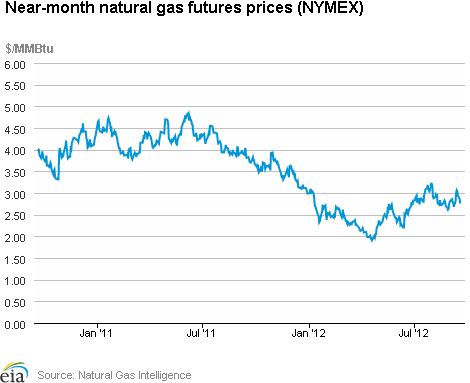
| U.S. Natural Gas Supply - Gas Week: (9/12/12 - 9/19/12) | ||
|---|---|---|
Percent change for week compared with: |
||
last year |
last week |
|
| Gross Production | 1.72%
|
1.57%
|
| Dry Production | 1.73%
|
1.58%
|
| Canadian Imports | 2.53%
|
-2.23%
|
| West (Net) | 29.06%
|
-4.47%
|
| MidWest (Net) | -20.21%
|
2.96%
|
| Northeast (Net) | 3.57%
|
-7.55%
|
| LNG Imports | -43.65%
|
13.27%
|
| Total Supply | 1.52%
|
1.31%
|
| Source: BENTEK Energy LLC | ||
| U.S. Consumption - Gas Week: (9/12/12 - 9/19/12) | ||
|---|---|---|
Percent change for week compared with: |
||
last year |
last week |
|
| U.S. Consumption | 5.20%
|
-3.72%
|
| Power | 16.64%
|
-13.11%
|
| Industrial | 1.14%
|
1.45%
|
| Residential/Commercial | -7.84%
|
12.93%
|
| Total Demand | 6.20%
|
-3.88%
|
| Source: BENTEK Energy LLC | ||
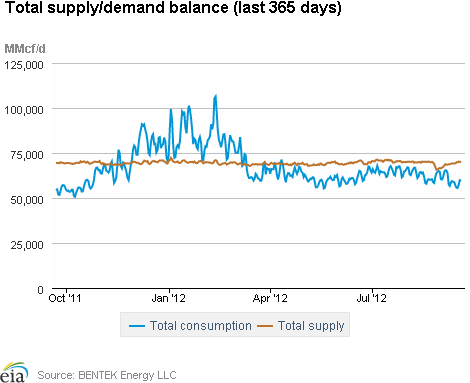
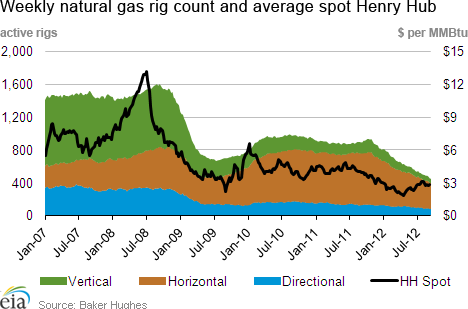
| Rigs | |||
|---|---|---|---|
Fri, September 14, 2012 |
Change from |
||
last week |
last year |
||
| Oil Rigs | 1,413 |
0.28% |
33.05% |
| Natural Gas Rigs | 448 |
-0.88% |
-50.88% |
| Miscellaneous | 3 |
0.00% |
-72.73% |
| Rig Numbers by Type | |||
|---|---|---|---|
Fri, September 14, 2012 |
Change from |
||
last week |
last year |
||
| Vertical | 524 |
1.75% |
-13.67% |
| Horizontal | 1,133 |
-0.18% |
-0.35% |
| Directional | 207 |
-3.27% |
-14.11% |
| Source: Baker Hughes Inc. | |||
| Working Gas in Underground Storage | ||||
|---|---|---|---|---|
Stocks billion cubic feet (bcf) |
||||
| Region | 9/14/12
|
9/7/12
|
change |
|
| East | 1,875 |
1,831 |
44
|
|
| West | 497 |
494 |
3
|
|
| Producing | 1,124 |
1,104 |
20
|
|
| Total | 3,496 |
3,429 |
67
|
|
| Source: U.S. Energy Information Administration | ||||
| Working Gas in Underground Storage | |||||
|---|---|---|---|---|---|
Historical Comparisons |
|||||
Year ago (9/14/11) |
5-year average (2007-2011) |
||||
| Region | Stocks (Bcf) |
% change |
Stocks (Bcf) |
% change |
|
| East | 1,736 |
8.0 |
1,799 |
4.2 |
|
| West | 442 |
12.4 |
445 |
11.7 |
|
| Producing | 997 |
12.7 |
974 |
15.4 |
|
| Total | 3,176 |
10.1 |
3,218 |
8.6 |
|
| Source: U.S. Energy Information Administration | |||||
| Temperature -- Heating & Cooling Degree Days (week ending Sep 13) | ||||||||
|---|---|---|---|---|---|---|---|---|
HDD deviation from: |
CDD deviation from: |
|||||||
| Region | HDD Current |
normal |
last year |
CDD Current |
normal |
last year |
||
| New England | 18
|
-2
|
9
|
18
|
11
|
-2
|
||
| Middle Atlantic | 12
|
-1
|
9
|
20
|
2
|
-12
|
||
| E N Central | 20
|
2
|
2
|
13
|
-5
|
-4
|
||
| W N Central | 23
|
-1
|
1
|
20
|
-6
|
-4
|
||
| South Atlantic | 4
|
2
|
3
|
66
|
-2
|
-5
|
||
| E S Central | 4
|
1
|
-3
|
52
|
-6
|
10
|
||
| W S Central | 1
|
-1
|
-1
|
86
|
-5
|
-6
|
||
| Mountain | 19
|
-9
|
3
|
43
|
-2
|
-3
|
||
| Pacific | 4
|
-5
|
4
|
54
|
20
|
8
|
||
| United States | 12
|
-1
|
3
|
43
|
1
|
-3
|
||
|
Note: HDD = heating degree-day; CDD = cooling degree-day Source: National Oceanic and Atmospheric Administration | ||||||||
Average temperature (°F)
7-Day Mean ending Sep 13, 2012
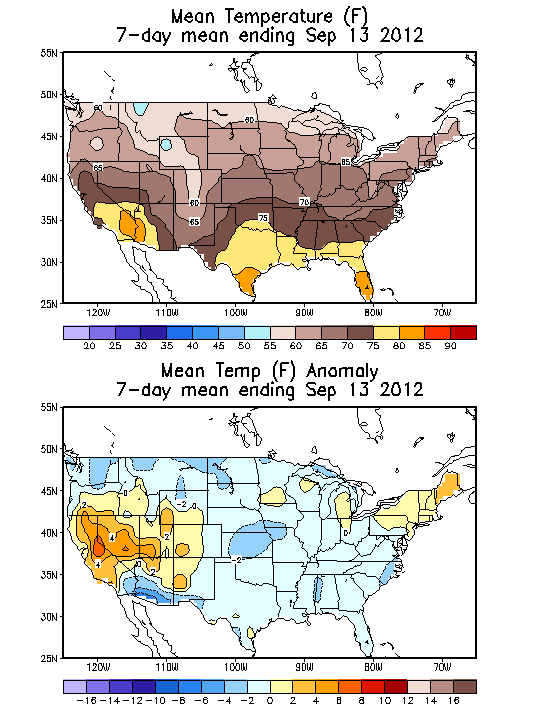
Source: NOAA/National Weather Service
Deviation between average and normal (°F)
7-Day Mean ending Sep 13, 2012

Source: NOAA/National Weather Service
